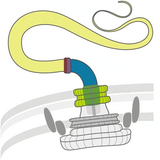| Part of a series on |
| Microbial and microbot movement |
|---|
 |
| Microswimmers |
| Molecular motors |
A biohybrid microswimmer also known as biohybrid nanorobot,[1] can be defined as a microswimmer that consist of both biological and artificial constituents, for instance, one or several living microorganisms attached to one or various synthetic parts.
In recent years nanoscopic and mesoscopic objects have been designed to collectively move through direct inspiration from nature or by harnessing its existing tools. Small mesoscopic to nanoscopic systems typically operate at low Reynolds numbers (Re ≪ 1), and understanding their motion becomes challenging. For locomotion to occur, the symmetry of the system must be broken.
In addition, collective motion requires a coupling mechanism between the entities that make up the collective. To develop mesoscopic to nanoscopic entities capable of swarming behaviour, it has been hypothesised that the entities are characterised by broken symmetry with a well-defined morphology, and are powered with some material capable of harvesting energy. If the harvested energy results in a field surrounding the object, then this field can couple with the field of a neighbouring object and bring some coordination to the collective behaviour. Such robotic swarms have been categorised by an online expert panel as among the 10 great unresolved group challenges in the area of robotics. Although investigation of their underlying mechanism of action is still in its infancy, various systems have been developed that are capable of undergoing controlled and uncontrolled swarming motion by harvesting energy (e.g., light, thermal, etc.).
Over the past decade, biohybrid microrobots, in which living mobile microorganisms are physically integrated with untethered artificial structures, have gained growing interest to enable the active locomotion and cargo delivery to a target destination. In addition to the motility, the intrinsic capabilities of sensing and eliciting an appropriate response to artificial and environmental changes make cell-based biohybrid microrobots appealing for transportation of cargo to the inaccessible cavities of the human body for local active delivery of diagnostic and therapeutic agents.
- ^ Kong, Xiangyi; Gao, Peng; Wang, Jing; Fang, Yi; Hwang, Kuo Chu (2023). "Advances of medical nanorobots for future cancer treatments". Journal of Hematology & Oncology. 16 (1): 74. doi:10.1186/s13045-023-01463-z. PMC 10347767. PMID 37452423.